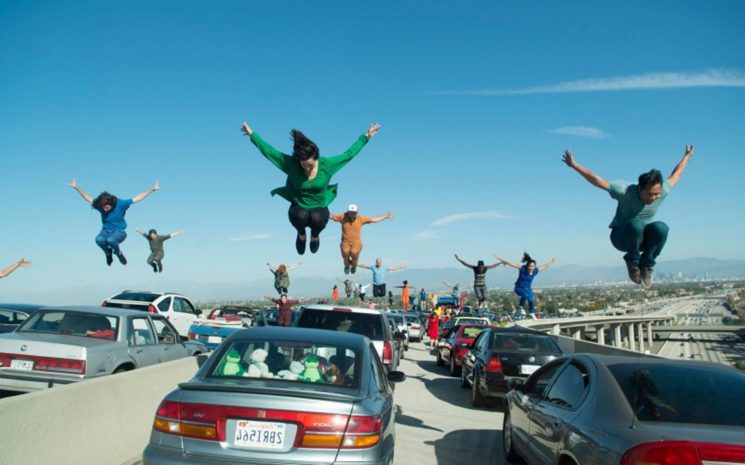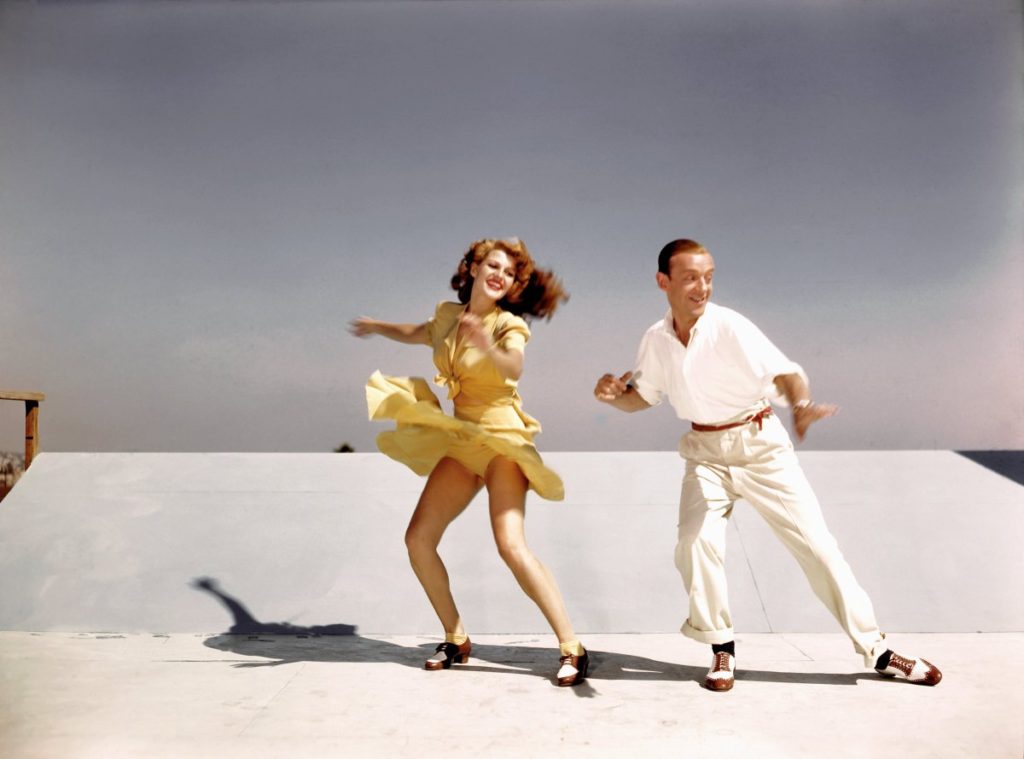On the occasion of La La Land, I wrote a piece for Globe Film about the history of dance as narrative scene on screen. You can read it here. (Go ahead, I’ll wait.) As a bonus, here’s my annotated, clips-filled guide to a few of the classic 1930s (and golden age of MGM’s Freed Unit) movie musicals that La La Land references.
First, however, in my feature on the legacy of dance and romance, I describe “Dancing in the Dark,” The Band Wagon’s Central Park duet, which is here:
One of my favourite Fred-and-Ginger dance numbers is that “I’ll be Hard to Handle” number from Roberta (1935) that I talk about at the end of my piece. Backstory of the set-up: Rogers is an American chanteuse faking her way through Europe as a Polish countess, complete with terrible accent (even when she sings). She drops the ruse when she runs into her childhood friend Astaire, an old crush. Their exchange perfectly encapsulates how dance can be a conversation, and I love how loose and at ease they are with one another. The movie’s interesting in that it’s their only headline film where they aren’t the principals of the romance plot conflict (Irene Dunne and Raldolph Scott are), their relationship is secondary, ostensibly. That allows for a genuine playfulness that you see less of in the later films as the stakes get higher, in my opinion. And that playfulness is great:
https://www.youtube.com/watch?v=rxXSk86q2Ks
“Cheek to Cheek”
Top Hat (1935, Mark Sandrich)
Dance is the dialogue that moves Ginger Rogers from emotionally aloof to rekindled romance in “Cheek to Cheek,” Irving Berlin’s dramatic, seductive and delicate song of requited love. It stands out as the signature number of their storied career. There were certainly revue-style movie musicals prior to this legendary pairing—like Footlight Parade, 42nd Street or the various Gold Diggers movies—but those showy production numbers generally interrupt the movie’s momentum as setpieces instead of furthering the plot. La La Land mostly takes its cue from this incorporated dance-as-storytelling approach that the duo’s early director Mark Sandrich and Fred Astaire’s longtime collaborator-choreographer Hermes Pan perfected.
“I Won’t Dance”
Roberta (1935, William Seiter)
Yes, it’s a solo, but the song “I Won’t Dance” is notable not only because it highlights Astaire’s talent as a pianist (a skill Ryan Gosling also worked on for La La Land). Astaire digs his heels in and sing-splains the subtext of the dance musical genre – and why he’s wary of even a seemingly innocent two-step with Ginger: “my heart won’t let my feet do things they should do.” Both the melody and lyrics include a callback to “The Continental,” the big finale from the Astaire/Rogers hit debut The Gay Divorcee (it won the first Academy Award for Best Original Song) but serves not only to remind us of that crowd-pleaser but of what’s really going on when they foxtrot together: “You kiss while you’re dancing.”
“The Shorty George”
You Were Never Lovelier (1942, William Seiter)
Requiring more gruelling practice hours than the movie’s other numbers combined (yet looks spontaneous), Rita Hayworth is the headstrong Maria seated at the edge of the dance floor in her father’s South American supper club. While she watches a rehearsal of Xavier Cugat’s orchestra, Astaire leans in and makes several attempts to cajole and impress her, until the toe tap she’s humoured him with gives way to enthusiasm and she finally gets up and joins him.
Their characters spar and she demonstrates herself as his equal in footwork; dancing together they’re simultaneously loose and crisp in this intricate number that combines American jive and tap. (It was conceived and named as a tribute to “Shorty” George Snowden, legendary dancer of Harlem’s Savoy Ballroom who originated Lindy Hop.) I could watch Hayworth dance all day.
The promotional photo that captures the pair practicing the routine on the Columbia Studios rooftop (Hayworth in vivid yellow dress and matching spectator shoes, like Emma Stone in La La Land) has only the sky behind them and is a buoyant dance moment for the ages.
“Danse”
Haut bas fragile (1995, Jacques Rivette)
The self-conscious 1930s backstage musical vernacular was also embraced and deconstructed by New Wave director Jacques Rivette in his only musical. The movement’s insistence on real locations combine with the deliberate artificiality of the musical genre in a unique, post-modern dance moment between would-be lovers Roland and Ninon. Pointedly, it takes place in a scenography workshop where a painted scrim backdrop of a city park (that favourite setting of golden age dance duets) is in progress. The pair kiss and begin not so much a dance as a series of classic poses that take place underfoot and across the scenic canvas on the floor. Rivette playfully tweaks the plain subtext at the end when sparks literally fly—courtesy of some convenient welding being done nearby.
“Duet”
The Young Girls of Rochefort (1967, Jacques Demy)
https://www.youtube.com/watch?v=AHGK2jiS548
La La Land opens with the ebullient “Another Day of Sun,” a colourful ensemble number of freeway gridlock on an off-ramp dotted with blue trucks. In the same way the opening sequence on a toll bridge in Jacques Demy’s Les Demoiselles de Rochefort stalls travel plans and suspends the travellers in time (and in the skyline), the dance number invites us to suspend disbelief and enter the world of the musical. (As does the extended opening scene in West Side Story, which serves as compressed story exposition through dance.) Less familiar here than Demy’s first musical The Umbrellas of Cherbourg, it also stars Catherine Deneuve but this time with her older sister Françoise Dorleac; they’re twin sister entertainers who dream of moving to Paris. Although it’s a clunky tonal mix of florid and somber, I prefer it (not least because both George Chakiris and Gene Kelly also star). Using a macaron pastel palette Demy slyly mashes up and nods to the genre history when he has the On the Town hoofer briefly fall into step with some sailor-suited strangers he passes in the street. There’s also a nod to RKO art directors Van Nest Polglase and Carroll Clark’s signature “big white set” and art deco aesthetics by setting this melodramatic Michel Legrand number between Kelly and Dorleac in an improbably grand music shop.
“I Feel Pretty”
West Side Story (1961, Jerome Robbins, Robert Wise)
https://www.youtube.com/watch?v=L7BQRGXFLJs
Not strictly speaking a dance number but an arch and playful performance by Natalie Wood in the tradition of movie musical girls nights (one that’s later seen more mockingly in “Sandra Dee” from Grease). It sets the tone for Emma Stone (remember, West Side Story won 10 Academy Awards) in La La Land: as they’re getting ready to go to a party and singing “Someone in the Crowd,” Stone and her roommates live in an inventively wallpapered, candy-coloured apartment that’s pure Jacques Demy, and the setup also echoes the traditional all-female boarding house where the hopeful chorines in 1930s backstage musicals live. (c.f. Stage Door, 1937.)
“De-Lovely”
Anything Goes (1956, Robert Lewis)
“Let’s take a walk,” Mitzi Gaynor suggests to Donald O’Connor aboard the ship taking them from Paris to New York. While Bing Crosby romances dancer Gigi Jeanmaire below deck, what she really means is let’s go for a spin. They sashay and tap and as Gaynor’s pink chiffon flutters in the ocean breeze, their shadow steps are lit from skylights underfoot. It’s up there with O’Connor and Vera Ellen’s elated pirouettes around the wine cellar in Call Me Madam (choreographed by Broadway’s Robert Alton) when they finally admit their feelings. O’Connor singing an ode to the ‘lovely’ night, now where have we heard that refrain recently?
“Broadway Melody Ballet”
Singin’ in the Rain (1952, Stanley Donen)
https://www.youtube.com/watch?v=BcYyxk_CAVs
and “Girl-Hunt Ballet”
The Band Wagon (1953, Vincente Minnelli)
The alternately energetic and angular, and sensuously sinewy finale (choreographed by Michael Kidd) spoofs hardboiled Mickey Spillane plotlines. Astaire shimmies along as the unwitting gumshoe to Charisse’s deceptive femme fatale (literally, a woman who reveals herself to be a siren — in a red dress) and her more innocent alter-ego victim as he looks for Mr Big. It’s glorious camp pantomime. The intentional artificiality of the painted backdrops and stylized sets in The Band Wagon (as well as An American Paris) are a credit to the MGM art director dream team Cedric Gibbons and set decorator Edwin Willis. They get an homage in Seb’s La La Land apartment (as painted by Stone) and in other sets-as-sets in the film, as well as in the epilogue dance sequence. Ultimately, director Damien Chazelle opts for surreal, self-reflexive and subverting traditional endings, genre conventions and audience expectations.
Further recommended reading: While on this recent dance history tangent, I found several good books about tap, dance and dance musicals. Of the books I read, I recommend:
Todd Decker’s Music Makes Me: Fred Astaire and Jazz
Charles Walters: The Director Who Made Hollywood Dance by Brent Phillips;
Brian Seibert’s award-winning What the Eye Hears;
America Dancing by Meghan Pugh;
The American Film Musical by Rick Altman;
Romantic Comedy in American Film from Lubitsch to Sturges by James Harvey;
and any of longtime former New Yorker dance and film critic Arlene Croce’s work.




